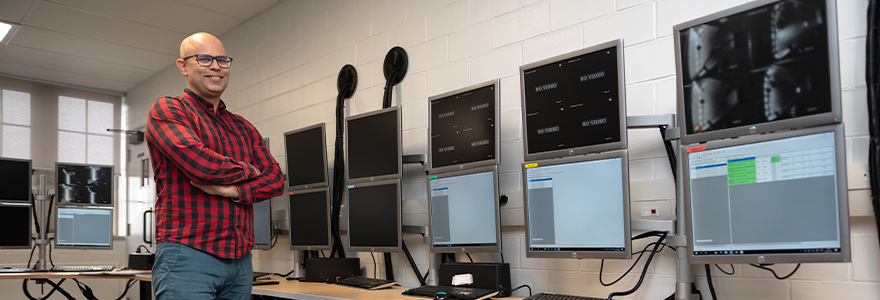Touchscreens and strawberry milkshakes: Investigators learn more about how our brain’s reward systems work
 Miguel Skirzewski, PhD, and fellow researchers are learning new approaches to therapeutic treatments.
Miguel Skirzewski, PhD, and fellow researchers are learning new approaches to therapeutic treatments.
By Cam Buchan
Using strawberry milkshakes, mouse models of disease, cutting-edge fibre optic technology, and touchscreens, researchers at Schulich School of Medicine & Dentistry have gained a better understanding of our brain’s reward networks. And in doing so, they are paving the way to new treatments for addiction and neuropsychiatric disease, such as schizophrenia, depression, and Parkinson’s disease.
“Our brains have reward systems: interconnected networks of brain cells that motivate us to seek the rewards that are basic to our survival, such as sex, food, drink, and social interactions,” said Miguel Skirzewski, PhD, lead author on a new study that recently appeared in Nature Communications. Tim Bussey, PhD, Marco Prado, PhD, Vania Prado, PhD, Lisa Saksida, PhD and Jane Rylett, PhD, were senior investigators on the paper.
Much of our behaviour can be traced back to activities in these networks, said Skirzewski, a research associate at Robarts Research Institute.
“These networks allow us to predict when rewards will happen, so we can design strategies and make decisions,” said Skirzewski. “Understanding these networks is essential to understanding how we function in the world.”
In a number of disorders, these reward networks are hijacked by addiction to drugs or alcohol, or compromised, as is the case with schizophrenia, depression, and Parkinson’s disease.
Mice rewarded with strawberry milkshakes
Skirzewski and collaborators from Western’s BrainsCAN-funded Mouse Translational Research Accelerator Platform (MouseTRAP) used a touchscreen-based mouse testing system, developed by Robarts Scientists Bussey and Saksida, to gather the data.
Mice were trained to use images presented on a touchscreen to predict when a strawberry milkshake reward would be delivered. During the exercise, researchers, using fibre optic methodologies, recorded rapid changes in specific neurochemicals used for communication between brain cells.
Some of the mouse models had deficits in the secretion of acetylcholine – a type of chemical messenger that plays an important role in learning and memory – and failed to learn the task. The researchers discovered that the neurochemicals dopamine and acetylcholine – both implicated in neuropsychiatric disease -- rapidly influence each other to support the prediction of a reward.
“In our study, mice learned whether certain cues, such as an image on the screen, helped them to predict rewards,” Skirzewski said. “This is a basic phenomenon known as Pavlovian conditioning, which is disrupted in many psychiatric disorders, in which the circuits that underlie reward prediction are thought to be compromised.”
Skirzewski said these tests can be easily adapted to humans and provide the insights needed to help understand a number of neuropsychiatric conditions.
“The brain processes information through these networks,” he said. “There is interaction between these different networks, which are all constantly talking to each other and affecting behaviours. One brain network does not control only one type of behaviour. With this methodology, we can detect how different brain networks interact.”
The research has implications for the way drugs are developed for neuropsychiatric disease, an enterprise which has met with limited success. Skirzewski cites treatments for multiple brain diseases.
“In the past, scientists tested treatments in animals, and got a positive result, but not necessarily because they understood how these treatments worked. Most drugs in use were created by trial and error,” he said. “With this approach, we can now understand mechanisms of disease at the molecular and circuit level. By understanding what is happening in the brain from a network perspective, we are now approaching drug development in a different way. It will help make the development of new therapeutic approaches much more efficient.”
This cutting-edge technology, including touchscreens, fibre photometry, and mouse models of disease like those used in this study are available to Western and Canadian researchers through BrainsCAN’s Mouse Translational Research Accelerator Platform (MouseTRAP).








